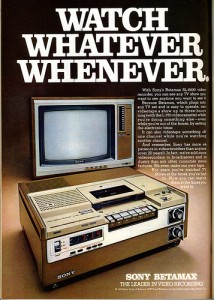
cc licensed flickr photo shared by Kekka
How many times have you heard that our students are nothing like we used to be? Well, I am here to echo that sentiment. They aren’t. Do students need the same caring and love that we had as children? Absolutely. But what our kids are exposed to now is something that we never had and frankly, it is pretty exciting.

Back in approximately 1980, my parents purchased a VCR and were torn to either purchase, Beta or VHS. Wisely, they chose VHS which became the predominant medium with recorded video. A machine that cost in the thousands at the time, weighed about 40 pounds and had two giant pieces; one for playing videos, and the other for recording TV shows. The opportunity was there to record any show (that was playing on the stations you had access to), as long as you were there to set up the recording and remembered. Now, I can access my PVR from anywhere in the world through my iPhone, and God forbid I forget, I can download the show from a number of paid or free (illegal) sites. Anything that we want to see is available to us.
Recently, I saw a fantastic episode of the Office that featured a fantastic storyline involving a snowball fight that I talked about with my friends. Amazingly within days, someone took all of the scenes regarding the “snowball fight” and made a mini episode. If you can think it, it might already exist.
Our students have access to information that we never did. Stephen Johnson talks about this increased access to technology:
“…the media and technology that our minds grapple with every day has grown at an exponential rate over that period, in both the complexity of the individual object and diversity of the overall ecosystem.”
Students are coming to school not only exposed to this media, but are also gaming a huge rate. Video game creators seemingly are creating games that are not too simple, yet challenging enough to keep the player entertained. This understanding of “Flow” theory ensures that the participant is engaged in learning the game environment. This same theory should be implemented into our classrooms:
“Make the learning environment too easy, or too hard, and students get bored or frustrated and lose interest. But if the environment tracks along in sync with the students’ growing abilities, they’ll stay focused and engaged.” Stephen Johnson, Everything Bad is Good For You
Our students are coming to school with this changing world all around them, but are schools changing with it? Are we incorporating Flow theory into our classrooms? Are we using media in our classrooms effectively? If you watch Sir Ken Robinson’s talk on the Changing Education Paradigms, he discusses how our students are so stimulated from the world around them, yet we are wondering why they are so hyperactive at school? He also goes as far to suggest that society is over-medicating drugs to deal with this. Should we not be changing the environment our students work in as opposed to trying to change our students?
Kids have changed because the environment that they have grown up in has changed. Schools need to not only change for these students, but they need to take advantage of all these opportunities. This is why I am excited. As an educator, we have access to opportunities and information that we never had as students. We need to be connectors for our kids, and help them learn to safely navigate and use this information so they can follow their passions.
Kids just aren’t what they use to be and am I have never been so excited 🙂
If you have never seen the Sir Ken Robinson video, it is a must for educators:
[youtube]http://www.youtube.com/watch?v=zDZFcDGpL4U[/youtube]